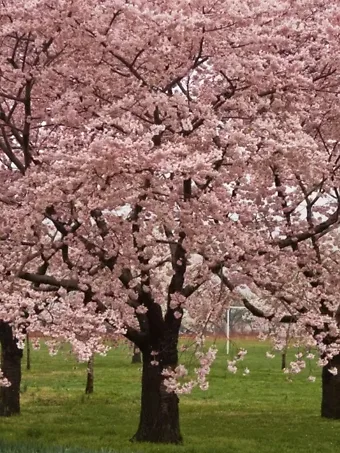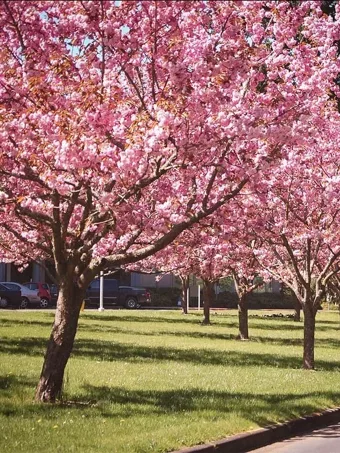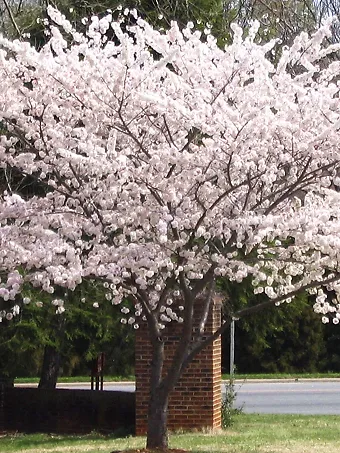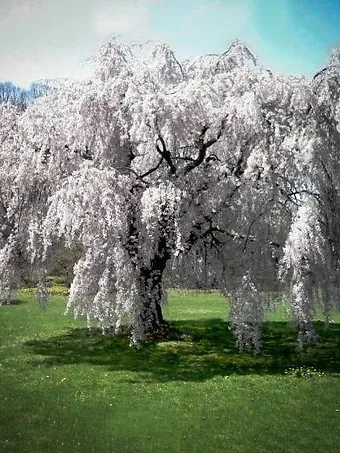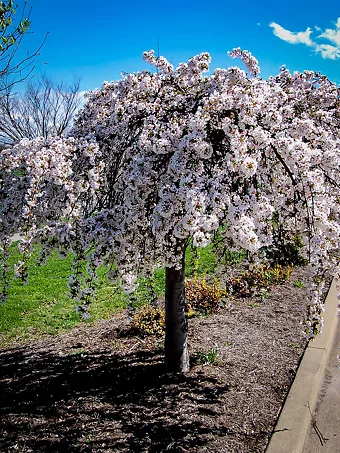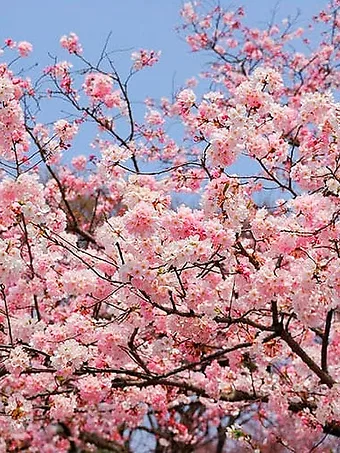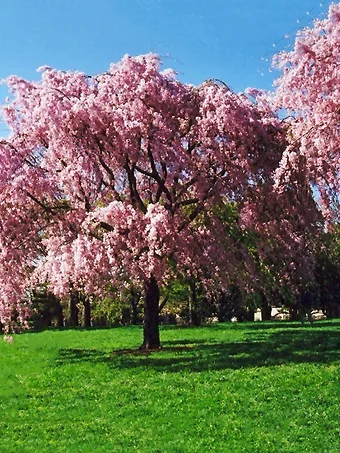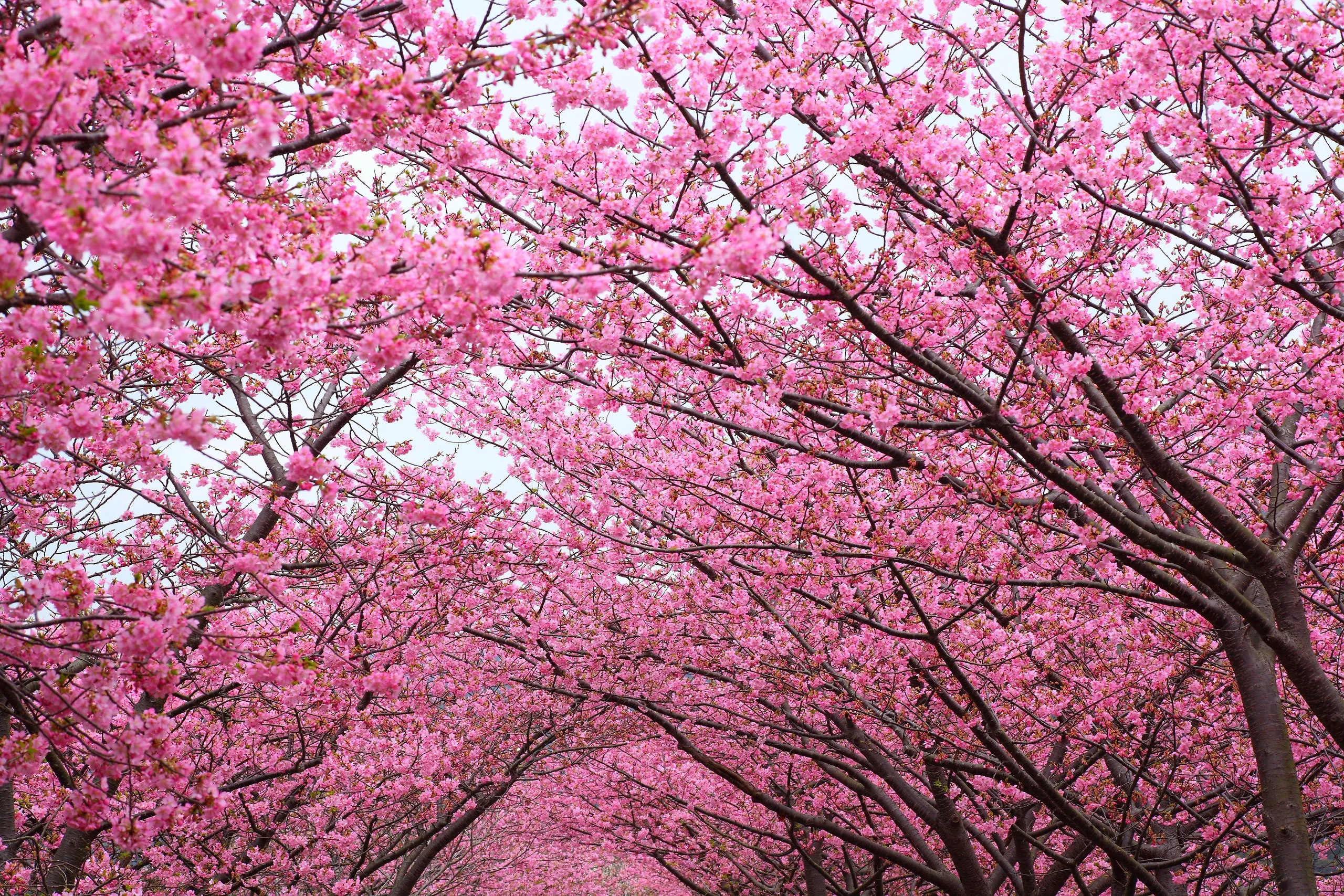
Written by s • All About The Cherry Blossom Tree
Gardening Tips: The Cherry Blossom Tree
The Cherry Blossom Tree is famous for its blooms, which have enticed writers, artists, and filmmakers alike. The light pink to ivory white blossoms flower in spring, offering soft, serene beauty to the garden atmosphere. The Cherry Blossom Tree includes several varieties; however the most commonly referenced cultivar is the Japanese Flowering Cherry, or the Yoshino Cherry Tree. Do not be deceived; flowering cherry trees do not fruit. This means no messy clean-up of over-ripe cherries.
Instead, the flowers will eventually fall to the ground, symbolizing the circuitous nature of life to the Japanese people. The Cherry Blossom Tree is a popular choice for landscapers and homeowners seeking a subtle flowering tree, which offers majestic strength over volatile coloring. Furthermore, while other flowering trees can require heavy pruning and maintenance, the Cherry Blossom Tree is relatively easy-to-grow. This medium growth flowering cherry tree grows easily in either full sun or mostly shade. Various soils and growing locations also make this a popular flowering tree.
You may be familiar with the Cherry Blossom Festival, which occurs in Washington D.C. once every spring. Like this festival, celebrations around the world surrounding the blooming of the Cherry Blossom Tree are common. The Cherry Blossom Tree is planted, therefore, not only because of its beauty, but because it represents the changing seasons. The gardener who chooses the Cherry Blossom Tree is rewarded time and time again by the 40 to 50 foot impressive magnitude of the flowering blossoms in springtime.
Cherry Blossom Trees do require moderate watering, as their native environment receives frequent rainfall. Be sure to provide a location where water is accessible. If water access is a concern, consider planting the Cherry Blossom in partial to almost full shade, thereby decreasing the evaporation of water. Using mulch can also help to ensure proper water conservation.
Given proper watering, the Cherry Blossom Tree is sure to delight the gardener who chooses it. Plant one today!
Quick Tips
Enjoy some quick tips here. For more complete information, read about these hints in more detail below.
Sunlight – Cherry Blossoms are flexible; plant in multiple exposures. Full sun, partial shade, or mostly shady locations will all work.
Soil – Plant in well-drained, moist soil that is not overly wet. Although adaptable to many soil types, Cherry Blossom Trees prefer acidic soils.
Water – During the first season, Cherry Blossom Trees require moderate watering care, preferably once a week for 30 minutes or to a depth of 18 inches. Once established, simply water once every two to three weeks.
Pruning – Pruning should occur in winter, while the tree is dormant only after it is established (5 years). Remove dead or diseased wood and do minimal cutting for shape.
Other Popular Flowering Cherries
The Best Places to Plant the Cherry Blossom Tree
Cherry Blossom Trees originated in eastern Asia, but today they cover much of the world. Australia, Canada, Turkey, Germany, South Korea, the Netherlands, India, Japan, the United States, and many other countries have festivals to celebrate their blooms annually.
In the United States, the Cherry Blossom Tree prefers USDA Hardiness Zones 5 through 8, preferring the subtropical to temperate climates of much of the middle latitudes. Plant the Cherry Blossom Tree in a variety of sun exposure regions, including full sun, partial shade, or mostly shade. The Cherry Blossom Tree, therefore, does well as either an accent tree in the yard’s center or tucked away with a small bench underneath. Some gardeners even plant several Cherry Blossom Trees in rows to create living borders for driveways or entryways.
Cherry Blossom Trees are tolerant of a variety of soil conditions. Sandy, loamy, or clay soils will all support the Cherry Blossom, so long as they drain well. The Cherry Blossom should not sit in standing water. In drier climates, some gardeners find that planting the Cherry Blossom Tree is full shade makes maintaining properly moist soil difficult. If you live in a location prone to severe droughts, consider planting the Cherry Blossom Tree in partial shade to reduce water evaporation. Also, using mulch can help conserve water and disperse it more evenly. Cherry Blossom Trees are mildly drought tolerant, but they do not withstand severe or long-term droughts easily.
This adaptably flowering tree is easy to grow in most yard locations. Simply provide adequate water, and the flowers will be the first of many thank-you gifts!
Growth Rate and Mature Height
The Cherry Blossom Tree is a medium sized flowering spectacle, reaching between 40 and 50 feet tall. Minimal pruning is needed for this cultivar, which naturally produces a rounded shape. The Cherry Blossom Tree exhibits a moderate growth rate, ranging between 2 and 4 feet a year.
Pests, Diseases, and Other Concerns
The Cherry Blossom Tree is hardy and typically avoids most pests and diseases. As with most trees, the best defense against these types of issues is a healthy tree. Monitor the growth and water the Cherry Blossom regularly, and most of the following diseases will not affect your tree.
Black Knot Fungus affects the joints and branches of the Cherry Tree. Small light-brown growths will appear, eventually rupturing. Remove any infected branches immediately. Over time, the entire tree can succumb to the fungus.
Silver Leaf Fungus affects the leaves of the plant, occasionally, but not always, leaving a silvery hue to the leaf. Branch die-back is the most common sign of the fungus. Remove diseased branches immediately.
Black Cherry Aphids will affect the leaves and twigs of the plant, often causing leaf curling. The aphids leave a secretion behind that induces the growth of a black fungus. Insecticides are one of the few options in this case.
Noteworthy Tips on the Cherry Blossom Tree
– The Japanese word for the Cherry Blossom Tree is “Sakura”.
– The flower of the Sakura symbolizes the life cycle to the Japanese people, epitomizing the springs, summers, falls, and winters of the human life.
– Cherry Blossom Trees do not produce edible fruits; smaller cherry fruits do grow, but these are typically only eaten by birds.
– The tree’s blossoms are pickled in salt and used in a variety of dishes, including ume vinegar, wagashi, and anpan.
– The leaves of the Cherry Blossom contain coumarin, which is a toxin when ingested in large doses.
